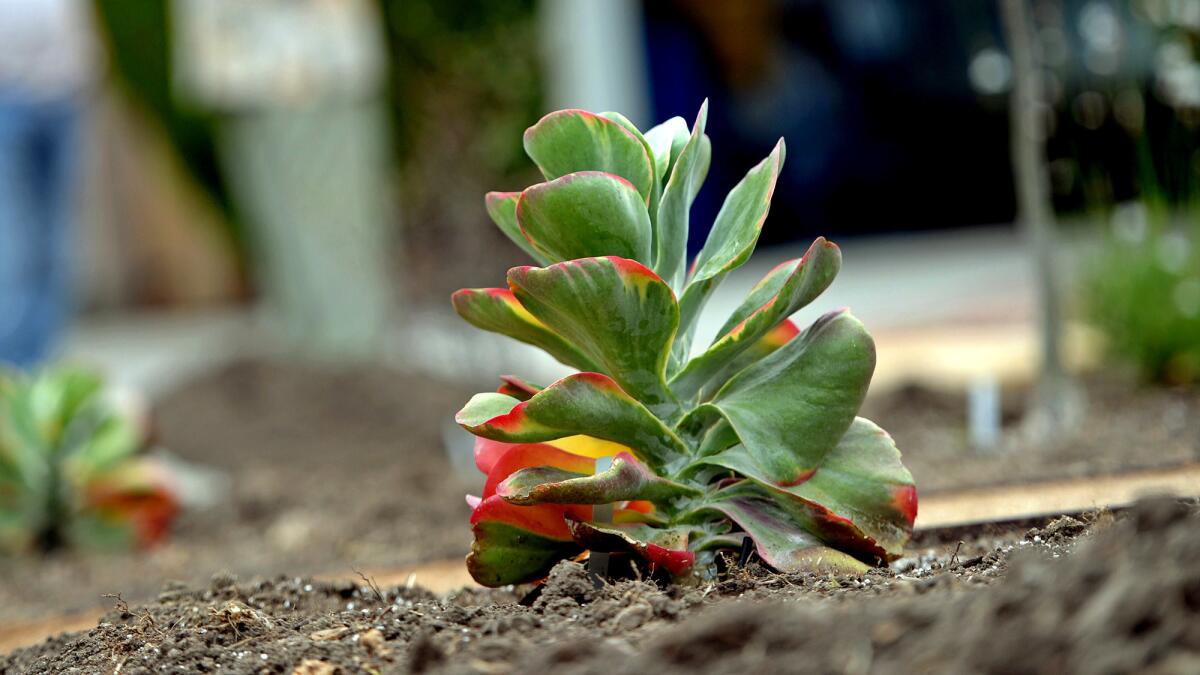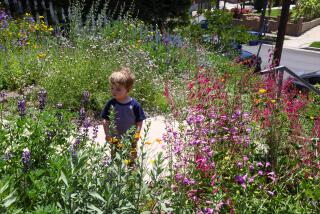Q&A: An HOA board does not have the authority to ban drought-tolerant landscaping

- Share via
Question: We live in Los Angeles and in an effort to conserve water we filled out an application asking our board for approval to remove our existing grass and plant a drought-resistant landscape. We received a letter back that shocked us. It said: “The board has denied your application for plantings in your front yard because our HOA is not a desert and succulents and cactus are not approved for primary front yard focal points. We do not want New Mexico, Arizona or Nevada desert landscape. The plan has to be ‘pretty.’ By way of example, we’ve included several different property addresses that have approved landscaping.”
After viewing all the approved landscaped property addresses the board provided, none have drought-resistant landscapes. Instead, they look like something out of a fantasy theme park complete with trellis walkways, garden gnomes, fake butterflies and dry water beds that go nowhere. There were endless rows of fluffy white roses making upkeep labor intensive, high maintenance and requiring a lot of water.
We have heard that some landscape applications have taken years to approve, with owners spending tens of thousands of dollars in plans alone. We don’t have that kind of money; we just want to conserve water and our expenses. How should we handle this so we don’t end up waiting years to change our front yard’s appearance?
Answer: If your governing documents require you to obtain association approval to make these changes to your landscaping then you must go through the proper procedures. Since your original application for planting the front yard was denied, follow the procedure set forth in the governing documents to appeal that decision or file an entirely new application.
However, your association must provide a “fair, reasonable, and expeditious procedure for making its decision” and must specify a maximum time for response to an application or request for reconsideration by the board, under Civil Code section 4765. It is unreasonable for the association to leave homeowners in limbo for years or cause unnecessary delays when landscaping changes or modifications are requested.
If you do not receive a timely response to your new proposal, or if you are not provided an opportunity to file an appeal to the board’s response, then you can consider seeking a remedy in another forum. Begin by availing yourself to the association’s internal dispute resolution process. After that, look to enlist a form of mediation or alternative dispute resolution. Such processes are provided for and detailed under state law, Civil Code sections 5900 to 5965.
California laws governing homeowner associations have typically favored a board’s ability to control the appearance of a development. In recent years, however, the Legislature’s interest in continuing such deference appears to have dried up when it comes to imposing landscaping requirements that are not in line with the state’s best interests.
Picturesque wonderlands of flowers are not only time-consuming and expensive to maintain, they are an unnecessary drain on our depleted water reserves. Under Civil Code section 4735(a), a provision of the governing documents, architectural or landscaping guidelines or policies shall be void and unenforceable if it prohibits the use of low-water-using plants, including to replace existing turf.
Although your board does not have to approve “succulents and cactus,” there are other drought-resistant plants available to you and the board cannot veto them all. To do so would be to render 4735(a) ineffective, which is beyond the powers of your board and your association. The Los Angeles County Department of Water and Power’s Environmental Program Division provides a Smart Gardening page on its website that answers questions about native and drought-tolerant plants for your area.
The program encourages use of California native and drought-tolerant plants in residential landscapes as an effective way to conserve water, reduce pesticide use and lower maintenance costs while supporting the local ecology. Prominent native and drought-tolerant plants and shrubs are listed along with how to care for them. The wide variety of pest-resistant plants include ones as diverse as flowering evergreens and fragrant sage.
If you have not already done so, you should appeal the board’s decision and request a reconsideration of its denial while reminding them of their obligations to assist you in conserving water. Encourage board members to broaden their horizons by allowing a wider variety of succulents and California indigenous plants. If the specific plants you have selected are not acceptable, then ask for guidance in choosing other plants. A starting point for discussion would be the Smart Gardening webpage: https://dpw.lacounty.gov/epd/sg/plants.cfm.
Zachary Levine, a partner at Wolk & Levine, a business and intellectual property law firm, co-wrote this column. Vanitzian is an arbitrator and mediator. Send questions to Donie Vanitzian, JD, P.O. Box 10490, Marina del Rey, CA 90295 or [email protected]
ALSO
Is Elon Musk trying to do too much too fast?
Dual-branded hotels are multiplying in Southern California
Electricians, roofers and plumbers have their pick of jobs, and demand is expected to grow
More to Read
Inside the business of entertainment
The Wide Shot brings you news, analysis and insights on everything from streaming wars to production — and what it all means for the future.
You may occasionally receive promotional content from the Los Angeles Times.










